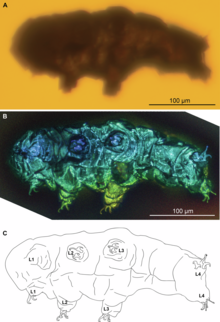| Beorn Temporal range: Late Cretaceous,
| |
|---|---|

| |
| Holotype specimen under various imaging techniques | |
| Scientific classification | |
| Domain: | Eukaryota |
| Kingdom: | Animalia |
| Phylum: | Tardigrada |
| Class: | Eutardigrada |
| Order: | Parachela |
| Family: | Hypsibiidae |
| Genus: | †Beorn Cooper, 1964 |
| Species: | †B. leggi
|
| Binomial name | |
| †Beorn leggi Cooper, 1964
| |
Beorn is an extinct genus of tardigrade and the first known fossil tardigrade, discovered c. 1940 and described in 1964 from Late Cretaceous amber from Manitoba, Canada. The genus contains a single species, B. leggi. It was originally classified as the only member of its family, the Beornidae, but was later reclassified as belonging to the Hypsibiidae.[1][2][3] It is one of three fossil tardigrades known from the Cretaceous, the others being Milnesium swolenskyi from the Turonian New Jersey amber and Aerobius from the same amber piece as Beorn.[4] The only other confidently known fossil tardigrade is the Miocene Paradoryphoribius from the Dominican Republic.[5]
In addition to some other finds from the Cretaceous and the Cambrian period, Beorn is an example of the early existence of tardigrades in earth's history, and its largely modern appearance suggests that tardigrades must have diversified considerably before this time.
The species was first described in 1964 by Kenneth W. Cooper. The type specimen is now in the Museum of Comparative Zoology at Harvard University. The generic name Beorn was chosen by Cooper in reference to a character of the same name from the children's book The Hobbit by J. R. R. Tolkien, which can occur both in the shape of a man and that of a bear. The specific name leggi refers to Cooper's student William M. Legg who collected the amber in the summer of 1940 in which the holotype was found. He died in 1953 before finishing his thesis at Princeton University. Cooper, Legg's friend and scientific mentor, named Beorn leggi after him.[1]
- ^ a b Cooper, Kenneth W. (1964-01-01). "The first fossil tardigrade: Beorn leggi Cooper, from Cretaceous amber". Psyche: A Journal of Entomology. 71 (2): 41–48. doi:10.1155/1964/48418. ISSN 0033-2615.
- ^ James H. Thorp; D. Christopher Rogers (6 September 2014). Thorp and Covich's Freshwater Invertebrates: Ecology and General Biology. Elsevier. p. 351. ISBN 978-0-12-385027-0.
- ^ Animal biodiversity: An outline of higher-level classification and survey of taxonomic richness. Magnolia Press. 2011. p. 96. ISBN 978-1-86977-849-1.
- ^ Mapalo, Marc A.; Wolfe, Joanna M.; Ortega-Hernández, Javier (2024-08-06). "Cretaceous amber inclusions illuminate the evolutionary origin of tardigrades". Communications Biology. 7 (1): 953. doi:10.1038/s42003-024-06643-2. ISSN 2399-3642. PMC 11303527. PMID 39107512.
- ^ Mapalo, Marc A.; Robin, Ninon; Boudinot, Brendon E.; Ortega-Hernández, Javier; Barden, Phillip (2021-10-13). "A tardigrade in Dominican amber". Proceedings of the Royal Society B: Biological Sciences. 288 (1960). doi:10.1098/rspb.2021.1760. ISSN 0962-8452. PMC 8493197. PMID 34610770.